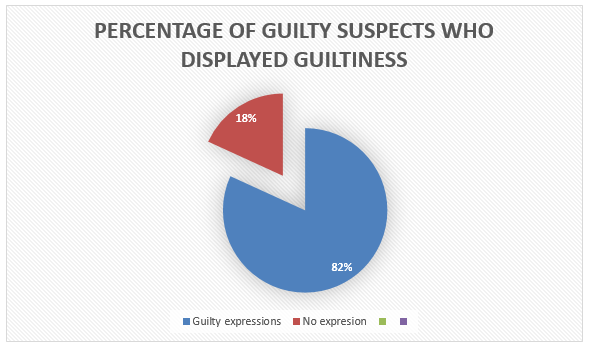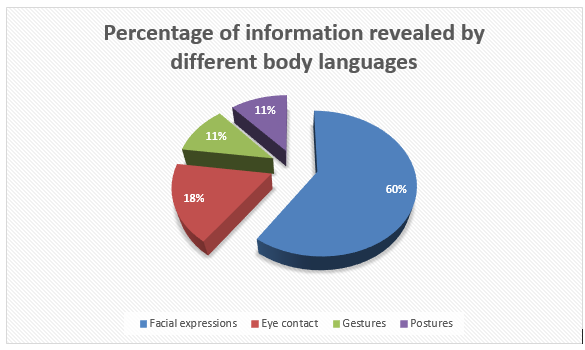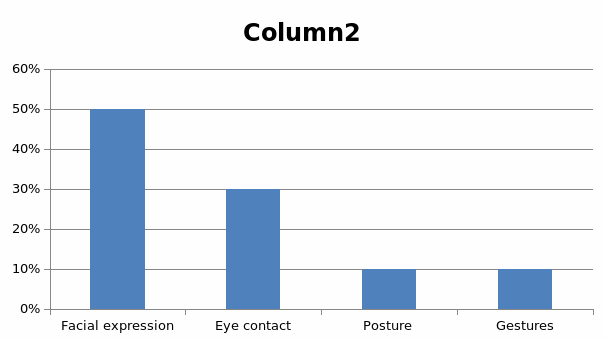Abstract
The main theme of this research is to prove that body language in court hearings can influence the interpretation process. A questionnaire was used in finding out how body language (eye contact, facial expression, posture, gestures, and others) manipulate interpretation in the corridors of justice. Many people think that verbal language is the most efficient way of communication, but body language passes across more information. The results showed that body language is responsible for most of our communication, is foolproof, and carries with it a lot of significance. For these reasons, the guiltiness or innocence of suspects can be easily determined and judges should embrace this for accurate judgment.
Introduction
Expressing or putting across what one wants, what one feels, what an individual thinks, or stating one’s opinion is another way of communicating for interpersonal effectiveness. Although verbal communication (listening and comprehending what an individual tries to put across) is regarded as the most efficient way of communication, body language (eye contact, facial expression, posture, gestures, and others) on the other hand plays an equally important role in communication.
When an individual chooses to communicate, he/she does it to execute a certain need. The individual while communicating might need something, he or she might be feeling uncomfortable or he/she has feelings and thoughts to put across. As stated by Nadig (1992) “In deciding to communicate, the person selects the method or code which he/she believes will effectively deliver the message to other people.
The code used to send the message can be either verbal or nonverbal. When the other parties receive the coded message, they go through the process of decoding or interpreting it to understand and meaning”. “Effective ways of communicating exists between the sender of the information and the receiver when the person receiving this information decodes it and gets the meaning out of it in the very way the person conveying the information intended it” (Nadig, 1992).
A study states that while communicating face-to-face, what we say accounts for only ten percent of the intended message. Whilst body language is responsible for most of our communication, verbal communication passes across the rest of the message (Bluff, 2002). This kind of communication is necessary, because when you pass one message verbally and the other one with body language the recipients are more likely to consider the message you are communicating using your body. Many people consider body language that encompasses body movements, facial expressions and levels of eye contact, mannerism, postures, gestures, and other forms of passing across the information using the body as important ways to pass information across (Ekman, 1997).
There is the saying that sometimes actions speak louder than words, which is why body language is used in the determination of many factors. This may be like dealing with a deaf individual, counseling and therapeutic session when passing information across to individuals who cannot understand your language when at a distance where one cannot use voice communication and to some extent it is used in the interpreting processes in court hearings (Bluff, 2002).
There has been a lot of research on body language and how information is passed across. The best one was done by Ekman (1997) who studied micro-expressions on people all over the world. Microexpressions are only a small part of body language. As a result, this report will cover the entire scope of body language and its meaning, especially in court. This report will therefore determine whether understanding body language in court hearings could influence the interpreting process. The hypothesis of this report is that body language can be used for interpretation in court hearings (Ekman, 1997).
Methodology
The method of research was by a questionnaire which was given out to 5 court interpreters who work in courtrooms during court hearings to relay information from different languages. The choice of the interpreters was good since they have adequate knowledge of court proceedings. The questionnaire was also given to 5 law students who were also conversant with court proceedings and matters of justice.
Both groups were exposed to 8 questions respectively making it a total of 16 questions. The questions generally concentrated on the bodily reactions of suspects during the hearing of their cases in court (this was mainly for the court interpreters) and the second set of questions presented to the law students were about the criteria used in judgment if a suspect displays evidence through body language and the accuracy of this kind of judgment. The results were finally collected and some of it presented in tables and graph form.
Results


Figure 1 shows the findings of the ratio of guilty suspects and their behavior as explained by court interpreters in court proceedings. The chart shows that of all guilty people surveyed it is evident that only a handful of them would manage to conceal suggestive expressions or body language which can influence judgment. In figure 2 the chart shows the most suggestive or the kind of body language that reveals information most as brought out by 5 court interpreters and 5 law students.


In figure 3 there is information about the percentage use of different kinds of body language in court proceedings. The probe showed that facial expressions are seen to convey more information than any other form of body language communication as it has a significance of about 50% of the total communication. Eye contact also has high significance and it has about 30% of the total. Gestures and body posture have about the same percentage of 10% each. In figure 4 there is the illustration of the percentage use of body and verbal language in court proceedings. It shows that body language reveals more than verbal language.
Table 1.
Table 2.
In the first table (table 1) the results investigated from 5 court interpreters show that many court proceedings use body language to determine evidence and pass judgment on suspects. There was only 1 incidence when an interpreter said it depended entirely on the evidence provided. The table also shows that a suspect cannot pretend to be innocent when guilty and that guiltiness can easily be identified. This was certified by all 5 interpreters who also said that courts do rely more on body language than verbal language.
In the second table, the interview concentrated on students studying law. The students being conversant to the judicial systems showed that judgment determined by body language is correct. One student thought it depended on the effectiveness or ineffectiveness of the verbal language and another one commended that it was entirely up to the judge to decide. They also showed that suspects cannot conceal the truth using body language as it is foolproof. They also explained that facial body language revealed more information than any other type of body language due to reaction to the questions asked.
Discussion and conclusion
According to the present research, the results support the investigated hypothesis that is body language can be used for interpretation in court hearings. It has been found that more than 60% of court judgments rely on body language while the rest (40%) is verbal language. In addition body language is foolproof and is one of the best ways of passing judgment and interpretation in court proceedings (Nadig, 1992). Moreover, these statistics can be very effective in the corridors of justice in passing judgment.
Consequently, the findings of this research followed the hypothesis and support it particularly. From figure (1) it can be seen that most suspects in court proceedings displayed guiltiness in their body language and only a small fraction of all proceedings did not show this. The reason for the latter was in the event of adequate evidence and body language was not necessary.
As explained by the 5 interpreters and 5 law students, the interpreting procedures in court hearings dependents entirely on the reliability and accuracy of the information, which include evidence and justifications used in deciding for the case. In court hearings judges do not just listen to what one says, they happen to look for any available feelings or possible intent beyond the words an individual says. The only other way judges can do this is by trying to interpret the body language of the individual. Unfortunately, body language can be interpreted but on very rare occasions wrongly since there are no specific criteria set for interpreting this.
Body language is a vital part of the whole communication process. It can determine either a positive or negative reaction from the one you are talking to. Examples of body language may come from any part of the body: eyes and eyebrows, lips, arms, and any other part that the receiver of the message sees. It is important to be aware of the different body actions that one does while conversing (or even when not speaking) to avoid unnecessary and even unpleasant reactions (Springer, 1996).
In the entire anatomy of an individual, the eyes and facial expressions pass more information than any other part (Friesen, 1974). This is displayed in figure (4) which shows facial expressions and eye contact take up 80% of all bodily language. Looking or gazing at an individual for a long time can build up pressure. Studies show that people who outstare others build up a sense of control over them. So in court situations continued gaze or eye contact can easily determine if an individual is sincere or not.
This information was researched from questions presented to court interpreters (Friesen, 1974). Shifting of eyes from time to time or blinking could imply the person is guilty or a deception. On the other hand, individuals who have relaxed eye movements and are composed are viewed, to be honest to what they are trying to pass across (Friesen 1974). According to the interpreter’s instances of body communications and the ways an individual’s body part can manifest include the following; an individual’s eyes and facial expressions are seen to be the doors to the soul since a person being addressed can know some of the thoughts that particular individual may be holding back.
On the other hand thou, the person being addressed may get altogether the wrong impression as he or she may misinterpret the information displayed by the person conveying the information from what he or she wants to be passed across (Ekman, 1997). Some of the most brought out elements are the movement or twitching of eyebrows, frowning, and smiling all these are highly suggestive. This suggests when a person is angry, fearful, disgusted, anxious, surprised joyful, or sorrowful (Ekman, 1997).
A good example of this kind of body communication researched by Lee (1998) is that it can express a worried or troubled mood. “This is when one has eyebrows converging in the middle, as with frowning. Even if you talk softly and slowly, the person whom you are interacting with may think that you are almost at your temper’s threshold” (Lee 1998).
Another part that is normally taken to mean the probable mood of an individual is the lips. Even though we have many shapes and positions for the lips, predominantly as to how they form, general ideas are showing how individuals would most likely feel while conversing. Some examples of this kind of communication shown by lee are:
A retracted lower lip that is almost bit by the upper teeth is usually a sign that the person is holding back and waiting for affirmation or action from the other person. On the other hand, a retracted upper lip that’s bit by the lower teeth usually signifies a person who’s holding back and keeping mixed reactions, as with a reaction to the message being conveyed by the other (Lee, 1998).
Such minute actions of the facial expressions have major implications to the judge or a court hearing and may serve as a basis to the evidence or the overall judgment this is as investigated on the 5 law students and the 5 court interpreters.
One more example presented by Friesen (1974) agreed with this hypothesis. The study showed that by examining the movements of over seventy muscles on the face involved in smiling, an experienced person can determine a true smile to a false one. “A person can look for the crinkle in the skin at the middle, outside corner of the eyes and if it is not there, the smile is probably not real. Genuine smiles are smiles that “crest” or change rapidly” (Friesen, 1974). This can transform from a tiny movement on the face to a big open expression.
In figure (4) there is evidence that Gestures, touching, and the way of standing are also highly suggestive ways of communication, although they only take 20% of the total percentage of body language. The way a person stands may show how confident he or she is or how comfortable the individual is, when an individual stands tall while speaking he/she will be confident in what is being said. The interview with the 5 court interpreters and the law students revealed that if the individual stands upright with hands put on the hips this will be a sign of preparedness or hostility.
The hands-on the other hand are seen to be responsible for a fairly large impression of body communication by gesturing (Bluff, 2002) because they are more profound and have a bigger implication. Putting arms across one’s chest signifies uncertainty, mistrust, anxiety, or closed-mindedness. Some energetic movements of the limps might suggest impatience, irritation, anger, or disgust (Nadig, 1992). And because actions are often louder than words, these body movements may be highly suggestive in influencing the judgment or the hearing of a court case. This is courtesy of this investigation (Nadig, 1992).
Ekman (1997) brought about the issue of micro expression that is vital for interpreting body language, especially in court situations. Ekman’s findings show that microexpression is a concise, unintentional expression common in human beings and apes. This is expressed especially when trying to hold back a certain emotion. Ekman’s research was a shot in the arm on this study but it was not exhaustive as it mainly concentrated on facial expression. The study showed the following:
Ekman’s research on people from all over the world come up with these facial expressions, raised lip corners, and cheeks, narrowing of the eyelids to produce crow’s feet in the corners signifies happiness, narrowing eyebrows brought together, mouth turned down at the corners with the chin pulled up shows sadness, mouth and eyes open, eyebrows raised with nostrils flared at times displays fear, lowered eyebrows, wrinkled forehead, tensed eyelids and lips indicates anger, nose scrunching, upper lip raised, eyebrows downcast with eye narrowing denotes disgust, dropped jaws, relaxed lips and mouth, eyes wide open with slightly raised eyelids and eyebrows indicate surprise and raising the side of the mouth into a sneer or smirk shows contempt (Ekman, 1997).
Ekman’s research shows that these expressions carry with them a lot of significance although they only last a split second and many individuals may be unaware of this, the subconscious mind records them. This in turn uses the expressions in helping to establish an individual’s intended real emotion. Ekman provides a good example of a suspect who is being tried in court. “The smiling suspect may have a flash of a sneer before the smile erupts. This brief sneer may consciously be overshadowed by a longer smile, but may lead to a guilty sentence based on the subliminal micro expression”. This research supports figure one and two which shows that most information is relayed through facial expressions.
The main significant points were that suspects cannot show innocence when guilty, guiltiness can easily be identified through body language, courts rely more on body language than verbal language, a high percentage of judgment relying on body language is generally correct, a person cannot use body language to conceal the truth and that innocence can easily be revealed. As a consequence of these data it can be judged that the hypothesis was right (Bluff, 2002).
There were some limitations on the interviews. Firstly, the questions were not specific enough to test the hypothesis very well. For example, the respondents needed to fill in more information in the written and verbal interviews rather than just ticking. In addition to this, the scope and respondents were too small and inadequate thus necessitating more use on already researched work. According to this, the research may not be very specific. Therefore, it would be better to replicate the research on a larger scope involving more and different people.
To wrap up all this report reveals that these are the ways court judges determine the innocence or guiltiness of suspects in court hearings because they can easily determine the clues for deception and these body languages are not foolproof. Therefore as shown in this report body language is a mode of communication that can convey a lot of information between communicating parties. This communication can also be used in court hearings to determine the outcome of cases.
References
Bluff, W. (2002). Effective body language communication. Journal for communication development 24 (2), 62-69.
Ekman, D. (1997). Micro expressions and body language. Brisbane, QLD: John Wiley & Sons Australia Ltd.
Friesen, W. (1974). Facial expression as a form of body language. South Melbourne, VIC: Oxford University Press.
Lee, M. (1998) Lip reading. Foresight, 5(2), 15-23.
Nadig, A. (1992). Methods of communication. New York NY: Oxford University Press.